国家内部福利制度自下而上的图景:波多黎各边缘化社区的案例
Q2 Social Sciences
Journal of International and Comparative Social Policy
Pub Date : 2019-02-02
DOI:10.1080/21699763.2018.1526696
引用次数: 4
摘要
本文的主要目的有两个:(1)使用自下而上的方法对福利制度进行检查,从而能够根据接受者的看法对福利生产进行全面分析;(2)对一种以上的福利组合在国家层面上跨政策部门共存的检验。福利制度的分类是按照自下而上的方法进行的,并依赖于福利提供者在满足社会风险和促进福祉方面的重要性。考虑了三个传统的(如国家、市场、家庭)和一个替代的福利提供者(如社区)。数据是通过在波多黎各七个边缘化社区进行的20次半结构化访谈收集的。结果显示了以下福利领域的国内福利混合的五种配置:住房、营养、保健、教育、产妇/父亲、残疾、工作-失业和老年。本文提出了国内福利制度的理论建议,以及福利组合中的替代提供者。本文章由计算机程序翻译,如有差异,请以英文原文为准。
A Bottom-up picture of intra-national welfare regimes: the case of marginalised communities in Puerto Rico
ABSTRACT The main purpose of this article is twofold: (1) an examination of welfare regimes using a bottom-up approach, which enables a comprehensive analysis of welfare production based on recipients perceptions; and (2) an examination of more than one type of welfare-mix coexisting inside the national level across policy sectors. A classification of welfare regimes is carried out following a bottom-up approach and relying on the basis of the importance of welfare providers to satisfy social risks and promote well-being. Three traditional (e.g. state, market, family) and one alternative welfare providers (e.g. community) are considered. Data is collected through twenty semi-structured interviews in seven marginalised communities of Puerto Rico. The results show five configurations of intra-national welfare-mixes across the following welfare areas: housing, nourishment, health, education, maternity/paternity, disability, work-unemployment and older-age. This paper contributes to the theoretical proposals of intra-national welfare regimes, and alternatives providers in the welfare-mix.
求助全文
通过发布文献求助,成功后即可免费获取论文全文。
去求助
来源期刊

Journal of International and Comparative Social Policy
Social Sciences-Sociology and Political Science
CiteScore
3.70
自引率
0.00%
发文量
18
 求助内容:
求助内容: 应助结果提醒方式:
应助结果提醒方式:


